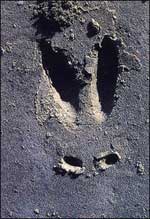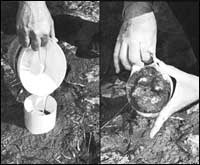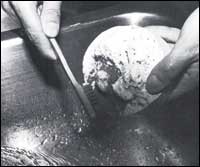Making Tracks

It is easy to identify the split hoof and dewclaw of a deer.
Indians, who were recognized for their ability to read animal signs, could look at a track, identify the animal, and tell when the track was made. Since each animal leaves its own peculiar imprint, the naturalist who develops tracking skills should be able to recognize not only the species, but occasionally an individual animal.
Since many animals wait until dark to travel and eat, probably the best time to look for clear tracks is early in the morning while the prints are still relatively fresh. Muddy areas around water should have a good selection of tracks because many animals gather there to drink. Predators also visit such areas, because the water makes them good hunting sites.
Some people enjoy collecting tracks. One way is to use a camera, as we have done. To obtain a good photograph, find a sharp, clean track in the open sunlight. Midmorning and mid-afternoon are the best times to take your pictures because the sun is bright enough to give you a good exposure and low enough to cast a faint shadow in the print. The picture you take will preserve the image and record the area surrounding the track.
Another way to collect a track is to make a plaster cast of it. The cast will be an accurate record of the length, width, and depth of the imprint.

Pour the plaster of Paris mixture into the form that has been placed around the track.
Making a cast is easy. All it takes is water, dry plaster of Paris, something to stir the mixture in and something with which to surround the track being cast. This surrounding frame can be a can with the top and bottom removed, a square section cut and removed from a milk carton or a two-inch strip of poster board stapled or clipped to form a circle.
Once you have found a good track, remove any loose particles of dirt, twigs, leaves, or other litter. Place the frame around the track and press it firmly into the ground for support, or surround the outside edge with soft dirt to keep the plaster mixture from running out. Allow at least one inch of the frame to extend above the track.
Stir the plaster and water together, adding the water slowly until the mixture is about as thick as heavy cream or pancake batter. Pour it slowly into the mold until the plaster is about an inch deep. Allow the plaster to harden for twenty to thirty minutes. If the ground is damp, the hardening process may take a little longer.
When the plaster is hard, lift the cast off the track and remove the frame. Allow the cast to finish hardening overnight and then clean it with water and a toothbrush. A knife can be used to smooth any rough edges.

Remove the cast when it has hardened, but allow it to dry overnight before scrubbing off the dirt.
The cast you have made is just the reverse of the track imprint. Now if you want to make a casting of the track as it appeared in the ground, apply a thin coating of petroleum jelly to the plaster track and the surrounding surface. Place it on a flat surface and surround it again with a frame. Stir up another batch of plaster and pour it into the frame. If you want to use the finished cast as a wall plaque, place a loop of wire in the exposed surface while the plaster is still soft. Allow two hours for the plaster to harden.
When the casting is dry, remove it from the frame and separate the two layers. The petroleum jelly should keep them from sticking together. Wipe the track clean and wash it in running water. Smooth any rough places with a knife blade or use fine sandpaper.
To make the track stand out more clearly from the surrounding plaster, paint it with india ink or black poster paint when the casting is completely dry. A coating of clear shellac or clear plastic spray may be applied to protect and preserve the casting.
Collecting and identifying tracks can be an interesting hobby. Some books that will help you are: A Field Guide to Animal Tracks by Olaus J. Murie (Riverside Press); Animal Tracks and Hunter Signs by E. T. Seton (Doubleday & Company); Animal Tracks by George R Mason (William Morrow & Company); Animal Tracks: The Standard Guide for Identification and Characteristics by H. Marlin Perkins (Stackpole Company).
More About Animal Tracks
Texas
Tracks: Do You Know Them?  (PDF 459.1 KB)
(PDF 459.1 KB)
Ilo
Hiller
1990 – Making Tracks: Introducing Mammals to Young
Naturalists. The Louise
Lindsey Merrick Texas Environment
Series, No. 10, pp. 96-100.
Texas A&M University
Press, College Station.